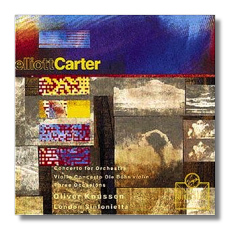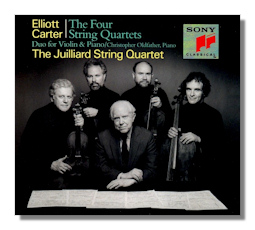
The Internet's Premier Classical Music Source
Related Links
- Recommended Recordings
Recommended Biographies
CD / DVD Reviews - Charles Rosen on Elliott Carter
- Recommended Carter Discography
-
Find CDs & Downloads
Amazon - UK - Germany - Canada - France - Japan
ArkivMusic - CD Universe
Find DVDs & Blu-ray
Amazon - UK - Germany - Canada - France - Japan
ArkivMusic-Video Universe
Find Scores & Sheet Music
Sheet Music Plus -
Recommended Links
Site News
Elliott Carter

(1908 - 2012)
Elliott Carter (December 11, 1908 - November 5, 2012), though a late bloomer in both individual style and in renown, has established himself as one of the most influential figures in American new music. His early music, including the ballet Pocahontas (1939) and his Symphony no. 1 (1942), reflects the neo-classical influences of studies with Walter Piston and Gustav Holst at Harvard (1926-32) and with Stravinskian disciple and master pedagogue Nadia Boulanger in Paris.
The late 40's, through the independent polyphony of the Piano Sonata (1946) and Cello Sonata (1948), saw the beginning stages of what would become Carter's distinctive style. His individual voice came to the fore with the composition of the First String Quartet (1951). Composed in the Arizona desert (with the aid of a Guggenheim Fellowship), this piece is characterized by four overlapping movements in a deeply complex rhythmic style, with sharply atonal writing, and a feeling of constant motion and change. This feeling of continuous mutation is most often attributed to Carter's frequent use of "metric modulation" in which two distinct tempi are related by an often small or complex division of the beat. (e.g., one sixteenth note quintuplet of one measure equals one eighth note triplet of the next.) Though this term was not coined by Carter himself, he is most often the composer associated with this rhythmic technique.
The Second String Quartet (1959) follows this style even further so that each of the four instrumental parts are distinctly independent from one another, each carrying its own "persona" made up of specific intervalic structures, textures, tempi, or articulations. The Third String Quartet (1971) is instead made up of two contrasting duos sharing ten unequally divided movements (the violin I/'cello group plays four movements, the violin II/viola group plays the remaining six) in a way that the duos constantly overlap. Silences between movements are employed only in order to bring the opposing duo to the fore. Again, Carter strictly assigns certain musical attributes to each duo, delighting in setting the two in clear contrast.
Also composed in this period are the Double Concerto for Harpsichord and Piano (1961) and the Concerto for Orchestra (1969). The Double Concerto assigns a separate chamber orchestra to each soloist, while the Concerto for Orchestra consists of four separate ensembles using four distinct styles of music. Both works exploit the small scale tactics of the string quartets in a much larger and timbrally and texturally diverse ensemble, adding an even more complex and intense aspect to Carter's stylistic traits.
Three important vocal works between the years of 1975 and 1981 bring a level of "humanism" and a touch of lyricism back to Carter's writing, though the overall techniques of composition remain very much in tact. This triptych of chamber cantatas – A Mirror on Which to Dwell for soprano (1975), Syringa for mezzo (1978), and In Sleep, In Thunder for tenor (1981) – is often thought of as contrasting compositional period, although this analysis ignores several significant instrumental works such as A Symphony of Three Orchestras (1976) and the Duo for Violin and Piano (1974).
The last 10 years have found Elliott Carter still at the height of his career, with no signs of a slowing output. A Fourth String Quartet (1986), a Violin Concerto (1990), and Partita (1993), and a wide range of new, virtuosic pieces for small ensembles or unaccompanied solo instruments have solidified Carter's monumental place in music history. ~Aaron M. Cassidy
Recommended Recordings
Concerto for Orchestra
- Concerto for Orchestra; Violin Concerto, Three Occasions for Orchestra/Virgin Classics CDC59271
-
Oliver Knussen/London Sinfonietta
- Concerto for Orchestra with Ives/Sony SMK60203
-
Leonard Bernstein/New York Philharmonic Orchestra
- Concerto for Orchestra; Piano Concerto, Three Occasions for Orchestra/Arte Nova 74321-27773-2
-
Michael Gielen/Southwest German Radio Symphony Orchestra
 String Quartets
String Quartets
- Four String Quartets; Duo for Violin & Piano/Sony S2K47229
-
Julliard String Quartet
- Four String Quartets; Elegy/Etcetera KTC1065 & KTC1066
-
Ariditti String Quartet
Quartets #1 & 4 - KTC1065:
Amazon - UK - Germany - Canada - France - Japan - ArkivMusic
and Quartets #2 & 3, Elegy - KTC1066:
Amazon - UK - Germany - Canada - France - Japan - ArkivMusic
or reissued as a 2CD set KTC2507:
Amazon - UK - Germany - Canada - France - Japan - ArkivMusic - CD Universe - JPC - String Quartet #4 with Babbitt & Powell/Music & Arts CD606
-
Composers String Quartet















